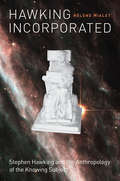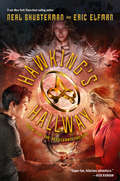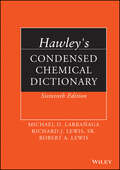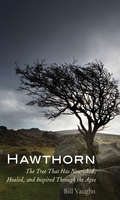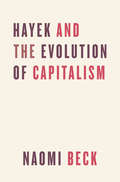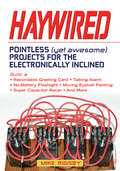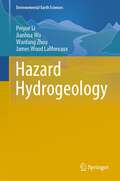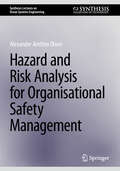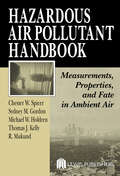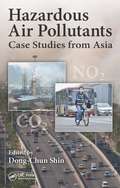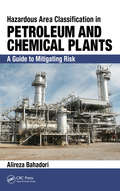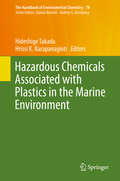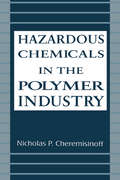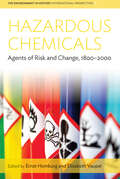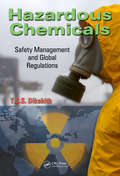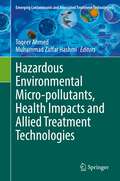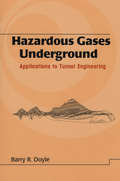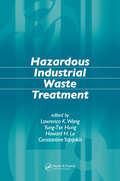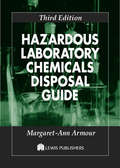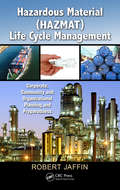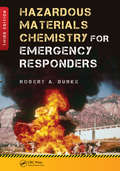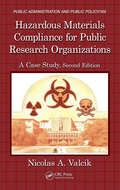- Table View
- List View
Hawking Incorporated: Stephen Hawking and the Anthropology of the Knowing Subject
by Hélène MialetThese days, the idea of the cyborg is less the stuff of science fiction and more a reality, as we are all, in one way or another, constantly connected, extended, wired, and dispersed in and through technology. One wonders where the individual, the person, the human, and the body are—or, alternatively, where they stop. These are the kinds of questions Hélène Mialet explores in this fascinating volume, as she focuses on a man who is permanently attached to assemblages of machines, devices, and collectivities of people: Stephen Hawking. Drawing on an extensive and in-depth series of interviews with Hawking, his assistants and colleagues, physicists, engineers, writers, journalists, archivists, and artists, Mialet reconstructs the human, material, and machine-based networks that enable Hawking to live and work. She reveals how Hawking—who is often portrayed as the most singular, individual, rational, and bodiless of all—is in fact not only incorporated, materialized, and distributed in a complex nexus of machines and human beings like everyone else, but even more so. Each chapter focuses on a description of the functioning and coordination of different elements or media that create his presence, agency, identity, and competencies. Attentive to Hawking’s daily activities, including his lecturing and scientific writing, Mialet’s ethnographic analysis powerfully reassesses the notion of scientific genius and its associations with human singularity. This book will fascinate anyone interested in Stephen Hawking or an extraordinary life in science.
Hawking Incorporated: Stephen Hawking and the Anthropology of the Knowing Subject
by Hélène MialetThese days, the idea of the cyborg is less the stuff of science fiction and more a reality, as we are all, in one way or another, constantly connected, extended, wired, and dispersed in and through technology. One wonders where the individual, the person, the human, and the body are—or, alternatively, where they stop. These are the kinds of questions Hélène Mialet explores in this fascinating volume, as she focuses on a man who is permanently attached to assemblages of machines, devices, and collectivities of people: Stephen Hawking. Drawing on an extensive and in-depth series of interviews with Hawking, his assistants and colleagues, physicists, engineers, writers, journalists, archivists, and artists, Mialet reconstructs the human, material, and machine-based networks that enable Hawking to live and work. She reveals how Hawking—who is often portrayed as the most singular, individual, rational, and bodiless of all—is in fact not only incorporated, materialized, and distributed in a complex nexus of machines and human beings like everyone else, but even more so. Each chapter focuses on a description of the functioning and coordination of different elements or media that create his presence, agency, identity, and competencies. Attentive to Hawking’s daily activities, including his lecturing and scientific writing, Mialet’s ethnographic analysis powerfully reassesses the notion of scientific genius and its associations with human singularity. This book will fascinate anyone interested in Stephen Hawking or an extraordinary life in science.
Hawking's Hallway (The Accelerati Trilogy #3)
by Neal Shusterman Eric ElfmanReaders who enjoy strange science, quirky humor, and out-of-this-world plot twists will be captivated by this third and final book in the electrifying Accelerati Trilogy from New York Times bestselling and award-winning author Neal Shusterman and author/screenwriter Eric Elfman.Nick Slate, in order to protect his father and little brother, reluctantly must help the Accelerati complete Tesla's great device. Their power-mad leader wants nothing less than to control the world's energy -- but there are still three missing objects to track down.Nick's friends can't help him, as they are spread across the globe grappling with their own mysteries -- with Vince in Scotland, Caitlin and Mitch on their way to New Jersey, and Petula's whereabouts unknown. On his own, Nick must locate Tesla's final inventions -- which are the most powerful of all, capable of shattering time and collapsing space.Read more in the Accelerati Trilogy:Tesla's AtticEdison's Alley
Hawks In Flight
by Pete Dunne Clay Sutton David SibleyAmong the world's most popular birds, hawks can be some of the most difficult birds to identify. They're most often seen flying high above and at a distance. In the first edition of Hawks in Flight, Pete Dunne, David Sibley, and Clay Sutton presented a holistic method of hawk identification, using general body shape, the way they move, and the places they are most likely to be seen. The new edition of the book that Roger Tory Peterson called a "landmark" integrates an array of carefully selected photographs, David Sibley's superb illustrations, and a clear, information-packed text and takes raptor identification to a higher level. This edition covers all of the raptors that breed in North America, including those with limited ranges in Florida, the Southwest, and Texas. Picking up where its predecessor ended by including two decades of raptor identification refinement, Hawks in Flight summarizes and places in users&’ hands an identification skill set that used to take years to master. The unique alchemy of Dunne, Sibley, and Sutton—including their collective experience of more than one hundred years watching hawks—make this book a singular achievement and a must-have for anyone interested in hawks.
Hawks at a Distance: Identification of Migrant Raptors
by Jerry LiguoriThe ultimate field manual for identifying distant raptorsThe ultimate must-have guide for identifying migrant raptors, Hawks at a Distance is the first volume to focus on distant raptors as they are truly seen in the field. Jerry Liguori, a leading expert on North American raptors, factors in new information and approaches for identifying twenty-nine species of raptor in various lighting situations and settings. The field guide's nineteen full-color portraits, 558 color photos, and 896 black-and-white images portray shapes and plumages for each species from all angles. Useful flight identification criteria are provided and the accompanying text discusses all aspects of in-flight hawk identification, including flight style and behavior. Concentrating on features that are genuinely observable at a distance, this concise and practical field guide is ideal for any aspiring or experienced hawk enthusiast.The first guide to focus on distant raptors as they are viewed in the fieldNew information and approaches for identifying distant raptorsIllustrates twenty-nine species in various lighting situations and settings558 color photos and 896 black-and-white images depicting plumage and shape characteristicsAll aspects of in-flight hawk identification, including flight style and behavior
Hawley's Condensed Chemical Dictionary
by Richard J. Lewis Michael D. Larrañaga Robert A. Lewis1471 new definitions, 5,236 revised or updated definitions, a new Chemical Abstract Number index, and an update of all trademarks Significant expansion of both chemical and biochemical terms including the addition of biochemical terms in the emerging fields in biology and biological engineering such as synthetic biology, highlighting the merging of the sciences of chemistry and biology Updates and expands the extensive data on chemicals, trade name products, and chemistry-related definitions Adds entries for notable chemists and Nobel Prize winners, equipment and devices, natural forms and minerals, named reactions, and chemical processes Update on toxicological profiles
Hawthorn
by Bill VaughnOne of humankind's oldest companions, the hawthorn tree is bound up in the memories of every recorded age and the plot lines of cultures across the Northern Hemisphere. In Hawthorn, Bill Vaughn examines the little-recognized political, cultural, and natural history of this ancient spiky plant. Used for thousands of years in the impenetrable living fences that defined the landscapes of Europe, the hawthorn eventually helped feed the class antagonism that led to widespread social upheaval. In the American Midwest, hawthorn-inspired hedges on the prairies made nineteenth-century farming economically rewarding for the first time. Later, in Normandy, mazelike hedgerows bristling with these thorns nearly cost the Allies World War II. Vaughn shines light on the full scope of the tree's influence over human events. He also explores medicinal value of the hawthorn, the use of its fruit in the world's first wine, and the symbolic role its spikes and flowers played in pagan beliefs and Christian iconography. As entertaining as it is illuminating, this book is the first full appreciation of the hawthorn's abundant connections with humanity.
Hayek and the Evolution of Capitalism
by Naomi BeckFew economists can claim the influence—or fame—of F. A. Hayek. Winner of the Nobel Prize, Hayek was one of the most consequential thinkers of the twentieth century, his views on the free market echoed by such major figures as Ronald Reagan and Margaret Thatcher. Yet even among those who study his work in depth, few have looked closely at his use of ideas from evolutionary science to advance his vision of markets and society. With this book Naomi Beck offers the first full-length engagement with Hayek’s thought from this perspective. Hayek argued that the capitalism we see in advanced civilizations is an unintended consequence of group selection—groups that adopted free market behavior expanded more successfully than others. But this attempt at a scientific grounding for Hayek’s principles, Beck shows, fails to hold water, plagued by incoherencies, misinterpretations of the underlying science, and lack of evidence. As crises around the globe lead to reconsiderations of the place of capitalism, Beck’s excavation of this little-known strand of Hayek’s thought—and its failure—is timely and instructive.
Haywired: Pointless (Yet Awesome) Projects for the Electronically Inclined
by Mike RigsbyDemonstrating that not all science needs to be serious to be educational or worthwhile, the electrifying projects in this packed resource offer science enthusiasts and weekend workbench hobbyists odd creations that will amuse them for years to come. Helpful hints on soldering, wire wrapping, and multimeter use pair with step-by-step details and circuit diagrams to show garage electricians how to build projects such as a no-battery electric car toy and a flashlight that only needs minutes of charging to shine for 24 hours. The instructions in this book are clear and concise, and an index includes websites listing suppliers and part numbers.
Hazard Hydrogeology (Environmental Earth Sciences)
by Wanfang Zhou Peiyue Li Jianhua Wu James Wood LaMoreauxThis book addresses geohazards by establishing their unique hydrogeological conceptual site models. Geohazards occur in many forms and scales either naturally or induced by human's activities. Many geohazards such as earth fissure, ground collapse and subsidence, mine water inrush, and groundwater contamination are closely related to hydrogeological conditions and their dynamics. Water, either surface water or groundwater, acts as a resource and an enabling agent that elevates geohazard risks in areas that are inherently vulnerable. The book presents case studies to describe identification and investigation methods, monitoring and early-warning techniques, modeling approaches, and engineering measures to prevent, control, and mitigate these geohazards. It targets students, researchers, practitioners, and decision makers who are engaged in water resource management, project planning, and geohazard control and management.
Hazard and Risk Analysis for Organisational Safety Management (Synthesis Lectures on Ocean Systems Engineering)
by Alexander Arnfinn OlsenThis book provides a comprehensive exploration of health and safety in the workplace, focusing on critical safety design, functional safety, and applying risk analysis. Through this book, readers will learn to navigate the complex landscape of organizational safety management, ensuring safe systems of work in hazardous environments. The chapters cover topics such as preliminary hazard identification and analysis, understanding and applying risk analysis, and constructing robust safety cases and arguments. The authors present an expert analysis of these themes through the lens of real-world examples and empirical research. Readers will also discover diverse perspectives from renowned scholars and practitioners in the field, making this book a must-read for anyone involved in organizational safety management. This book is essential for health and safety professionals, industrial and process engineers, and students at all levels studying engineering or safety courses. By the end of this volume, readers will be equipped with the knowledge to explain core principles of organizational safety management and apply them effectively in their work environments.
Hazardous Air Pollutant Handbook: Measurements, Properties, and Fate in Ambient Air
by Thomas J. Kelly Chester W. Spicer Sydney M. Gordon Michael W. Holdren R. MukundHazardous Air Pollutant Handbook: Measurements, Properties, and Fate in Ambient Air provides a comprehensive review of the 188 compounds and compound classes designated as Hazardous Air Pollutants (HAPs) by the Clean Air Act Amendments of 1990, with a specific focus on their potential presence in ambient air. The relevant chemical and physical prop
Hazardous Air Pollutants: Case Studies from Asia
by Dong-Chun ShinHazardous Air Pollutants: Case Studies from Asia examines the variety of public health problems, such as cardiovascular disease, respiratory disease, increased mortality, and impaired mental health, that are severely affecting multiple Asian countries as a result of exposure to high concentrations of air pollution in the wake of rapid industrializa
Hazardous Area Classification in Petroleum and Chemical Plants: A Guide to Mitigating Risk
by Alireza BahadoriDue to an increase in the wide-range of chemicals in petrochemical processing industries, as well as frequency of use, there has been a steady rise in flammability problems and other hazards. Hazardous Area Classification in Petroleum and Chemical Plants: A Guide to Mitigating Risk outlines the necessities of explosion protection in oil, gas and ch
Hazardous Chemicals Associated with Plastics in the Marine Environment (The Handbook of Environmental Chemistry #78)
by Hideshige Takada Hrissi K. KarapanagiotiThis volume consists of 15 chapters and focuses on hazardous chemicals, how they are associated with plastics, and their environmental risks. It includes background information on plastics and additives chemistry, and their observed or potential effects on living organisms as well as the oceanographic aspects of marine debris dispersion. The respective chapters provide insights into the sorption/desorption of chemicals in and out of plastics, the mechanisms and kinetics, but also the scale of the concentrations of chemicals found in marine debris, particularly in microplastics. The occurrence of the various chemicals is analyzed, as well as the distribution profiles of the chemicals in microplastics throughout the world’s oceans. The implications of the fact that plastics carry within them several chemicals are discussed in detail. In closing, new research topics that warrant further attention are identified. The book will appeal to all scientists who are already working or interested in starting to work on the topic of marine debris, as well as policymakers, NGOs and the broader informed public.
Hazardous Chemicals in the Polymer Industry (Environmental Science And Pollution Ser. #14)
by NicholasP. CheremisinoffProvides accurate, up-to-date information on the hazardous properties of several hundred generic and specific polymeric additives used in elastomer and plastics processing operations, detailing the symproms of overexposure as well as resonsible packaging, shipping and emergency-response procedures. Essential safety data is offered.
Hazardous Chemicals: Agents of Risk and Change, 1800-2000 (Environment in History: International Perspectives #17)
by Ernst Homburg Elisabeth VaupelAlthough poisonous substances have been a hazard for the whole of human history, it is only with the development and large-scale production of new chemical substances over the last two centuries that toxic, manmade pollutants have become such a varied and widespread danger. Covering a host of both notorious and little-known chemicals, the chapters in this collection investigate the emergence of specific toxic, pathogenic, carcinogenic, and ecologically harmful chemicals as well as the scientific, cultural and legislative responses they have prompted. Each study situates chemical hazards in a long-term and transnational framework and demonstrates the importance of considering both the natural and the social contexts in which their histories have unfolded.
Hazardous Chemicals: Safety Management and Global Regulations
by T.S.S. DikshithAn easily accessible guide to scientific information on safety management of chemical substances for students and occupational health professionals, this book covers proper management, related care, and precautions, and related global regulations. It aids in preventing and minimizing the consequences of catastrophic releases of toxic, reactive, flammable, or explosive chemical substances, which may result in toxic or explosive hazards. It also details safety measures for transportation of chemical substances by different routes, such as by road, rail, air, and sea.
Hazardous Environmental Micro-pollutants, Health Impacts and Allied Treatment Technologies (Emerging Contaminants and Associated Treatment Technologies)
by Muhammad Zaffar Hashmi Toqeer AhmedThis volume discusses hazardous environmental micropollutants, their impacts on human health, and possible means to mitigate their associated risks. The book features chapters that cover a variety of topics related to environmental micropollutants, which include dusts, infectious particles, heavy metals, organophosphates, atmospheric toxic organic micropollutants, fungal spores, pollutants from E-waste, antibiotic waste, and more. In addition impacts on human health and the environment, economic issues are addressed, with potential policy solutions offered. This work is timely, as hazardous micropollutants in soil, water and air are becoming more common, and this environmental contamination is leading to increasing instances of suboptimal human health outcomes. The book will be of interest to students and researchers in environmental pollution and remediation technology, microbiologists, and environmental regulators.
Hazardous Gases Underground: Applications to Tunnel Engineering (Civil and Environmental Engineering)
by Barry DoyleApplies detailed knowledge toward the design and construction of underground civil works projects. Develops critical skills for managing risk and designing reliable gas control measures within project time and cost constraints.
Hazardous Industrial Waste Treatment (Advances in Industrial and Hazardous Wastes Treatment)
by Lawrence K. Wang Yung-Tse Hung Howard H. Lo Constantine YapijakisIncreasing demand on industrial capacity has, as an unintended consequence, produced an accompanying increase in harmful and hazardous wastes. Derived from the second edition of the popular Handbook of Industrial and Hazardous Wastes Treatment, Hazardous Industrial Waste Treatment outlines the fundamentals and latest developments in hazardous waste
Hazardous Laboratory Chemicals Disposal Guide
by Margaret-Ann ArmourA perennial bestseller, this third edition includes individual entries for over 300 compounds. The extensive list of references has been updated and includes entries for 15 pesticides commonly used in greenhouses. Emphasis is placed on disposal methods that turn hazardous waste material into non-toxic products. These methods fall into several categories, including acid/base neutralization, oxidation or reduction, and precipitation of toxic ions as insoluble solids. The text also provides data on hazardous reactions of chemicals, assisting laboratory managers in developing a plan of action for emergencies such as the spill of any of the chemicals listed.
Hazardous Material (HAZMAT) Life Cycle Management: Corporate, Community, and Organizational Planning and Preparedness
by Robert JaffinIt is well known that fluorescent light bulbs and consumer appliances such as televisions, computers, and monitors contain mercury, dangerous chemicals, and other harmful components. The existing literature on hazardous materials addresses the risks attached to specific materials and emphasizes compliance and personal protective equipment (PPE) but
Hazardous Materials Chemistry for Emergency Responders
by Robert BurkeThe third edition of a bestseller, Hazardous Materials Chemistry for Emergency Responders continues to provide the fundamentals of "street chemistry" required by emergency response personnel. Emergency response and hazmat expert Robert Burke takes the basics of chemistry appropriate for response personnel and puts it into understandable terms. The
Hazardous Materials Compliance for Public Research Organizations: A Case Study, Second Edition (Public Administration and Public Policy)
by Nicolas A. ValcikCompletely revised and updated, Hazardous Materials Compliance for Public Research Organizations: A Case Study, Second Edition presents a case study of one university’s policies and practices with regard to the procurement, use, storage and disposal of HAZMAT in the context of a changing internal structure and regulatory environment. The author’s presentation is no-holds-barred, using interviews, archival documentation, and unobtrusive observations as a participant where the research institution was at times noncompliant with the new federal guidelines. See What’s New in the Second Edition: Incorporates issues with all types of hazardous materials instead of just focusing on biological HAZMAT Updated information on current regulations on HAZMAT in relation to universities and research centers Follow-up on the case study university, disclosing the university’s progress in resolving the security and safety shortcomings By implementing key improvements in safety and security, the universities can also more easily obtain research grant money and satisfy both state and federal safety requirements. This book includes recommendations to improve safety while using and storing biotoxins, chemical, radioactive material, and industrial waste, and to improve overall security at the university. It also highlights improvements that can make the environment a safer and more secure location to perform biological research.
